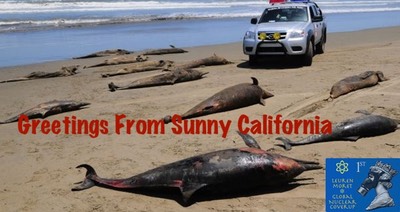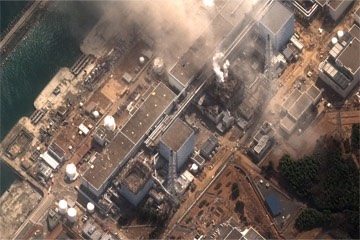Fallout and Reproduction of Ocean Fish Populations
E.J.
Sternglass,
Department of Radiology, School of Medicine,
University of Pittsburgh,
Pittsburgh, Pennsylvania 15213.
8oct71
We examined possible effects on the reproduction of fish populations in the ocean exposed to nuclear fission products from past atmospheric testing of nuclear weapons in connection with the possible environmental hazard from the escape of large amounts of radioactive debris as a result of unanticipated releases from underground nuclear detonations such as occurred recently in the "Baneberry" test (l,2).
The purpose of the study was to determine whether continued atmospheric testing by France and China or potential releases from underground detonations that might unexpectedly escape into the nearby fishing grounds could have detectable effects on the reproduction of fish populations similar to the unanticipatedly severe effects of low level radiation on the human embryo and fetus (2, 3, 4) recently confirmed by independent studies by other investigators (5, 6).
Nuclear Fallout causes Fish Population Decline
As will be shown below, very large declines of fish-populations after low-altitude nuclear tests followed by a gradual recovery to pretesting levels have been observed both in the Atlantic and Pacific, strongly suggesting that the eggs of fish and the developing young are far more sensitive to internal radiation from low-level fallout than had been anticipated, very much as in the case of the human-embryo and fetus. The method utilized involves an examination of existing statistical data on annual fish catches in various geographical areas, and correlating them with the known quantities of radioactive debris produced by nuclear detonations. This can be measured by the reported weapon yields, and by the measured concentrations of various fission products in the air and the ocean waters, as well as in fish, milk and human bone wherever such detailed data were available.
Since under conditions of constant or slowly changing sizes of fishing fleets and number of fishermen employed, the annual catches may be assumed to provide a reasonably accurate statistical sample of the total fish population similar to the reporting of fetal or infant births and deaths in large human populations, the official fishery statistics (7) may be readily used for such a study.
For the information on radioactivity released as well as for concentrations in the environment and diet, official publications of the U.S. Government (8, 9) and of the United Nations (10) are available.
As shown in Table I, there have been no sudden and drastic changes either in the total number of fishing boats or the number of men employed as fishermen in ocean-going vessels since World War II, either in the U.S. or the Norwegian fishing fleets. Gradual changes of the order of 2-4 % over a period of 1 to 2 years have, of course, occurred, but these would not influence sharp and sudden changes within the rather short reproductive cycles of the dominant volume of ocean fish.
The initial investigation involved the catch of fish in the North Atlantic by the Norwegian fishing fleet, which catches the largest tonnage of herring and other fish in the northern European waters between Norway, England and Iceland, a region for which accurate measurements of radioactive fallout have been available since the mid- 1950's.(10) This is also the area for which detailed studies on infant and fetal mortality in relation to fallout have already been carried out (2), thus permitting a direct comparison of the effects in man with those in the fish population in the same area.
The total tonnage of fish caught annually by Norwegian fishing vessels from 1955 to 1968 is tabulated in Table II, together with the measured concentrations of Strontium-90 in milk on both sides of the Atlantic for this time period. Also listed are the measured amounts of Strontium-90 in the bone of young children 0-4 years old (ll), which reflect the gradual build-up and decline of Strontium-90 in the food chain due to the relatively rapid turnover of calcium and Strontium in the bone of growing children.
Since the waters near the continental shelves in which herring and related fish such as the sardine, the salmon and the trout deposit their eggs reflect closely the radioactivity in the surface air (l2) , the measured concentrations of Sr-90 and Cs-137 in the northern hemisphere have also been listed in Table II. These data are more reliable than the relatively difficult measurements of radioactivity in sea-water, which is much lower than either in the rain, the milk or the bone of children, where biological concentration processes greatly increase the activity per unit mass.
Figure 1. North Atlantic Fishing Catch
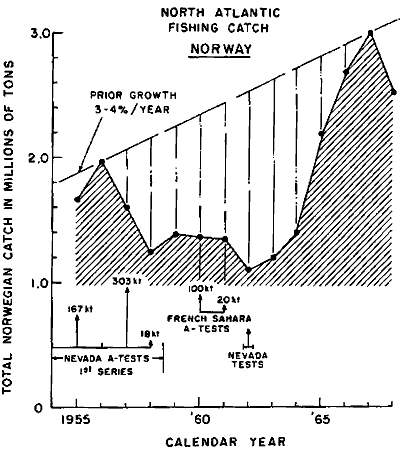
Strontium-90 and Cesium-137 are unfortunately the only isotopes out of many dozens for which detailed and extensive data are available. Thus, the very important contributions from the more biologically hazardous short-lived isotopes that dominate the radiation dose to the embryo over a period of weeks or months after the detonation of low-altitude, low yield weapons can only be estimated. However, at times of new releases, while activities in general are rising rapidly, the values of Strontium-90 are closely proportional to the total amount of fresh fission products such as Strontium-89, barium-140 and cerium-141.
Examination of Table II and the plot of total Norwegian fish catches in Figure 1 shows that a very large decline and recovery occurred between 1956 and 1966 , the period of heaviest atmospheric testing in Nevada, when the radioactive debris drifted north-east across the United States and the North Atlantic, giving the highest concentrations of Strontium-90 in the milk for Iceland and Norway among a11 European Countries(13).
Figure 2 and 3, Norwegian North Atlantic Catch losses
The t-test of statistical significance gives the correlation coefficients and t-values shown in Table III indicating a high probability that the association is not likely to be accidental.
It should be emphasized that although the correlations are carried out for Strontium-90, this particular isotope only serves as an indicator and is not necessarily the isotope that has the greatest effect on the reproduction process. Thus, early studies by German investigators (2 ) have shown that the rare-earth elements, one of which (Yttrium-90) is the daughter product of Strontium-90, tend to concentrate in the critical, growth controlling glandular organs such as the pituitary, adrenal and thyroid glands rather than in the bone.
As a result, the many short-lived rare-earth elements dominating tropospheric debris from small kiloton weapons such as cerium, lanthanum and yttrium are probably far more serious for the developing embryo of all species than Strontium-90 by itself. In fact, it is only as a result of such unanticipatedly efficient indirect affects on growth and resistance to disease that the very small amounts of radio-isotopes from fission releases could conceivably have such severe effects on infant mortality as have been observed for instance near the Dresden Nuclear Reactor and other nuclear facilities emitting activities well below those permitted by present AEC regulations. (14)
The nature of this mechanism on the developing young is illustrated by the fact that in the county containing the Dresden Reactor, the measured rises and declines of gaseous and liquid effluent were accompanied by matching rises and declines not only in infant mortality from respiratory and infectious diseases, but also by closely corresponding rises and declines in the number of babies born immature or underweight (2).
Similar effects on the developing fish-embryo and young fish would thus be expected to lead to a reduced ability to fight off diseases and natural enemies, leading to a decline in the total fish population within a year or two of the deposition of intensely active fresh fallout debris, generally within a few weeks after the detonation of weapons in the so-called "tactical" or kiloton range similar to the early atomic bombs used in Hiroshima and Nagasaki.
It is clear that these sudden effects highly associated with the rising and declining concentrations of radioactivity in the environment could not be explained solely on the basis of other pollutants. Thus, pesticides such as DDT have been showing a gradual, one way rise in concentration in the sea during the period in question, not the sudden rise and sharp decline observed in the effect on fish reproduction, which in the case of the North Atlantic actually permitted a greater embryo of all species than Strontium-90 by itself. In fact, it is only as a result of such unanticipatedly efficient indirect affects on growth and resistance to disease that the very small amounts of radio-isotopes from fission releases could conceivably have such severe effects on infant mortality as have been observed for instance near the Dresden Nuclear Reactor and other nuclear facilities emitting activities well below those permitted by present AEC regulations. (14)
The nature of this mechanism on the developing young is illustrated by the fact that in the county containing the Dresden Reactor, the measured rises and declines of gaseous and liquid effluent were accompanied by matching rises and declines not only in infant mortality from respiratory and infectious diseases, but also by closely corresponding rises and declines in the number of babies born immature or underweight (2 ).
Similar effects on the developing fish-embryo and young fish would thus be expected to lead to a reduced ability to fight off diseases and natural enemies, leading to a decline in the total fish population within a year or two of the deposition of intensely active fresh fallout debris, generally within a few weeks after the detonation of weapons in the so-called "tactical" or kiloton range similar to the early atomic bombs used in Hiroshima and Nagasaki.
It is clear that these sudden effects highly associated with the rising and declining concentrations of radioactivity in the environment could not be explained solely on the basis of other pollutants. Thus, pesticides such as DDT have been showing a gradual, one way rise in concentration in the sea during the period in question, not the sudden rise and sharp decline observed in the effect on fish reproduction, which in the case of the North Atlantic actually permitted a greater fish population in 1967 than in 1955, despite the rise in pesticide concentration as well as ordinary oil and chemical pollutants.
A similar conclusion, namely that ordinary air pollution appears to have a smaller effect on mortality at all than Strontium-90 and Cesium-137 in the diet for human populations has recently been reached by large-scale statistical studies involving some 61 standard metropolitan areas of the United States (15).
This does not mean that there may not exist serious effects of various chemical pollutants on deep ocean fish the same way that they have been amply demonstrated for the fish in our fresh-water lakes and streams. In there may well be serious synergistic effects involving the combined action of radiation and chemical pollutants far more serious than either acting alone. But the results of the analysis of the Atlantic fish catch strongly suggest that short-lived radioactive debris appears at this time to be the single most important contributor failure of fish reproduction under actual conditions existing in the Atlantic Ocean food chain.
Inasmuch as herring and related fish such as salmon and trout depend heavily for their diet during part of life-cycle on crustaceans known to concentrate such isotopes as Strontium, Yttrium and Iodine by factors many thousands (l6), the unexpectedly severe impact on reproduction, amounting to almost a 50% loss in total fish population of the North Atlantic by 1964 , appears to be connected with extremely effective biological concentration mechanisms not only in the organs of the fish but also in their food chain.
As a further check on the present hypothesis, the changes in the fishing catches by United States vessels in various parts of the Pacific Ocean were examined before and after the onset of nuclear tests in that area.
Figure 4 Alaska North Pacific Catch
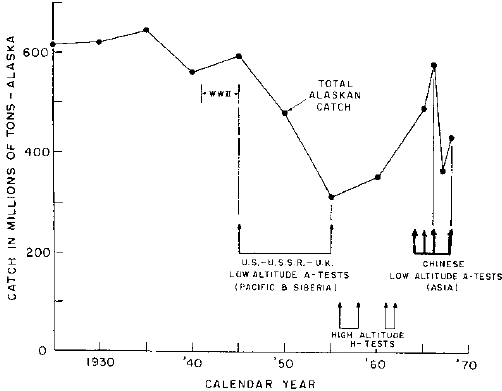
Figures 4 & 5 give the total catches for the two most important fishing areas, the Central and South Pacific as reflected in the California fish catch, and the Northern Pacific area at latitudes greater than 50°N represented by the Alaskan fishing catch.
Figure 5 California Catch from the Central & South Pacific
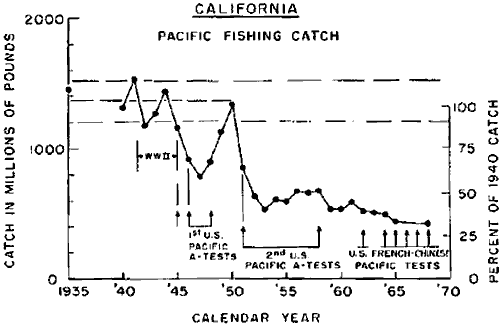
Examination of figures 4 and 5 both show the similar sudden drops in the fishing catches for these areas following known low-altitude nuclear detonations in their respective zones of latitude to which the fresh bomb debris is largely confined.
For the case of the Northern Pacific catch represented by Alaska, the pattern of decline and subsequent recovery is strikingly similar to that for the Norwegian catch at similar high latitudes. However, whereas the Norwegian catch declined most severely only after the onset of heavy Nevada testing in the early 1950's, the Alaskan catch shows evidence of declines beginning with the first Russian tests in nearby Siberia in 1949, directly upwind from Alaska.
By contrast, although recovery took place briefly in the California catch following the first series of small surface and underwater tests in Bikini and Eniwetok in 1946 and 1948, the massive continued testing of very large fission-fusion-fission weapons which took place in the Marshall Islands in 1954 followed by long series of massive tests by Russia, England, France and China appears to have prevented recovery of the Central and South Pacific fish catches which are now at levels only some 30% of what they were before massive nuclear tests began in the Pacific.
Nuclear Fallout is the dominant Ocean Pollutant
Two other considerations point towards nuclear fallout as the most serious of all present ocean pollutants as already suggested by Polykarpof (16).
1) Although ordinary industrial and chemical pollutants are far greater in the North Atlantic than in the South Pacific, the North Atlantic fish catch recovered and exceeded its pre-testing quantities following the cessation of atmospheric tests in Nevada, while the California catch in the latitudes receiving the heaviest Bikini and Eniwetok debris failed to recover with the continued testing by France and China.
2) Measurements of the concentration of radioactivity in surface waters have shown that the Pacific surface waters in the latitudes of the Bikini tests (0°-25°N) contain much higher concentrations of radioactivity than either the North Atlantic or the North Pacific, where most of the Norwegian and Alaskan catches originate. (12) Humans and Fish early show similar developmental mortality
Finally, it is important to note that the percent changes in fetal and infant mortality in man for the period of heavy Nevada testing (1951-1962) show closely the same effect per unit Strontium-90 in the milk of the Northern Hemisphere as the percent changes in fish populations as measured by the Norwegian catch. It appears that a change by 1 picocurie per liter out of typical average values of 10 pCi/1 during this period, or a mere 10% increase, led to a 4 +l% effect on, both infant mortality and fish populations within one to two years.
Based on the above data, it is possible to estimate that the deposition of only some 250 curies of Strontium-90 and its associated fresh fission products from a nuclear test appear to have led to a l% reduction in the California fish catch.
Using the figure of 1 kiloton of fission energy leading to the production of 0.1 kilo curies of Sr-90, this translates into a l% reduction in fish population for every 2.5 kilotons equivalent of fresh fission products released into the ocean. This amount is 2000 times less than the total yield of the "Canikin" warhead typical of the type now being tested for future use in anti-ballistic missile systems, designed to protect the United States from a massive first-strike by an enemy nation.
Thus, although a leak into the fishing grounds of the North Pacific is regarded as unlikely, the consequences of even a small escape of radioactivity localized as it would necessarily be, unlike in the case of an upper stratospheric detonation of such a warhead, could be of disastrous consequences both for the fishing industry and the fish and wildlife of the entire Northern Pacific.
References
1. An underground test code-named "Baneberry" in the 0-20 kt range was detonated on Dec. 18 1970 and discharged a radioactive cloud 8,000 feet into the air (N.Y. Times, Dec. 19, 1970). An examination of the resulting radioactive contamination and subsequent rises in infant mortality is given in Ref. (2), Sect. 15.
2. E.J. Sternglass "Environmental Radiation and Human Health", Proceedings of the 6th Berkeley Symposium on Mathematical Statistics and Probability, Berkeley, Cal, July 19-22, 1971 (J. Neyman, Editor) (Univ. of Calif. Press, 1971).
3. Sternglass, E.J., "Infant Mortality and Nuclear Tests", Bull. of the Atomic Scientists, April 1969, Vol. 25, pp. 18-20.
4. Sternglass, E.J., "Evidence for Low-Level Radiation Effects on the Human Embryo and Fetus", Radiation Biology of the Fetal and Juvenile Mammal, AEC Symposium Series Vol. 17, (Dec. 1969, p 693-717, Proceedings of the 9th Hanford Biology Symposium).
5. DeGroot M.H., Statistical Studies of the Effect of Low-Level Radiation from Nuclear Reactors on Human Health, Proceedings of the 6th Berkeley Symposium on Mathematical Statistics and Probability, Berkeley, Calif. July 19-22, 1971, (J. Neyman, editor) (Univ. of Calif. Press), 1971.
6. Lave, Lester B., Leinhardt, Samuel and Kaye, Martin B., "Low-Level Radiation and U.S. Mortality", working paper number 19-70-1, Grad. School of Industrial Administration, Carnegie-Mellon University, Pittsburgh, Pa. (July 1971).
7. Statistical Abstracts of the United States, U.S. Dept. of Commerce.
8. "The Effects of Nuclear Weapons", U.S. Department of Defense and U.S. Atomic Energy Commission, April 1962, Samuel Glasstone, Editor.
9. Radiological Health Data and Reports" published monthly by the Environmental Protection Agency.
10. "Reports of the United Nations Scientific Committee on the Effects of Radiation", United Nations, N.Y. (1958,1962,1964,1966,1969).
11. Ref. 10, 1969 Volume, p. 34 gives data for Northern Europe, U.S.S.R. and America.
12. Ref. 10, 1966, Volume, Appendix B, Figures 19-23, Maximum concentrations of Sr-90 for 1961 in the Pacific were 0.59 pC/1, compared with 0.18 pC/1 for the Atlantic.
13. Ref. 10, 1966 Volume, Table VIII, p. 72. 9
14. New regulations have just been proposed by the AEC which will lower most gaseous release concentrations by 100,000 times.
15. Ref. 6 also examines the milk sampling areas of the Public Health Service.
16. Polykarpof, Reinholt Publishing Company, N.Y., N.Y.
http://www.mindfully.org/Nucs/Fallout-Fish-Sternglass8oct71.htm
⚛ Editor's Corner ⚛
Not everyone knows quite who Doctor Ernest J. Sternglass is. I've included his C.V. here to help, for anyone who's not sure:
CV prof. dr. Ernest Sternglass
CURRICULUM VITA
ERNEST J. STERNGLASS, Ph.D.
Professor Emeritus of Radiology
EDUCATION
B. E.E., Electrical Engineering,Cornell University 1944
M.S., Engineering Physics, Cornell University, 1950
Ph. D. Engineering Physics, Cornell University, 1953
HONORS
Vice-President, Cornell Chapter, Eta Kappa Nu, Electrical Engineering Honorary Society, 1943-44
McMullen Research Fellowship, Cornell University 1949-51
Sigma Xi , National Research Honorary Society
Sigma Pi Sigma, National Physics Honorary Society
Fellow, American Physical Society
President, Federation of American Scientists, Pittsburgh Chapter, 1962-63
Westinghouse Research Fellowship, Institute of Theoretical Physics, University of Paris, 1957-58.
Westinghouse Research Fellowship, Institute of Theoretical Physics, Stanford University, 1966-1967
Citation for Excellence, Scientific Exhibit, Annual Meeting of the Radiological Society of North America, 1979
Citation for Excellence, Scientific Exhibit, Annual Meeting of the American Roentgen Ray Society, 1981
George Brussel Award for Public Service,1982
Honorary Professor Emeritus of Radiology, University of Pittsburgh,1983
Leo Goodman Award for Public Service, 1985
PROFESSIONAL EXPERIENCE
Professor Emeritus of Radiology, Department of Radiology, University of Pittsburgh School of Medicine, 1983-present.
Adjunct Professor of History and Philosophy of Science, Department of History and Philosophy of Science, Indiana University, Bloomington, Indiana (1979-1984).
Professor of Radiology and Consultant, Imaging Division, Department of Radiology, University of Pittsburgh, School of Medicine (1974-1983).
Professor of Radiology and Director, Laboratory of Radiological Physics and Engineering, Department of Radiology, University of Pittsburgh, School of Medicine, 1967 - 1974.
Professor of Radiological Physics, Department of Radiation Health, University of Pittsburgh Graduate School of Public Health, 1967 - 1974.
Visiting Professor, Institute for Theoretical Physics, Stanford University, Palo Alto, California, 1966 - 1967.
Advisory Physicist and Assistant to the Vice-President for Research and Development of the Westinghouse Research Laboratories, and Scientific Director of the Apollo Lunar Scientific Station Program, Westinghouse Research Laboratories, Pittsburgh, Pennsylvania, 1960 - 1967.
Fellow Scientist, Electronics and Nuclear Physics Department Westinghouse Research Laboratories,1958-1960.
Visiting Professor, Institute Henri Poincare, Sorbonne, Paris, France, 1957 -1958.
Research Scientist, Electronics and Nuclear Physics Department, Westinghouse Research Laboratories, 1952-1957.
Research Fellow, Cornell University, 1949 - 1951.
Instructor, Physics Department, George Washington University, Washington, D.C. 1946 - 1947.
Research Engineer, Electricity and Magnetism Department, U. S. Naval Ordnance Laboratory, White Oak, Maryland, 1946- 1952.
Science Writer, Science Service News Service, Washington, D.C.1946.
Military Service, U. S. Navy, (Radar and Electronics), 1945 - 1946.
Teaching Assistant, Physics Department, Cornell University, 1943-1944.
PROFESSIONAL SOCIETIES
American Physical Society (Fellow)
Radiological Society of North America (Ret.)
American Association of Physicists in Medicine (Ret.)
American Association for the Advancement of Science
American Astronomical Society
New York Academy of Sciences
Federation of American Scientists
Philosophy of Science Association
PATENTS
Thirteen patents in the areas of Image Intensifiers for Nuclear Medicine and Astronomy; Television Camera Tubes for Space Astronomy, Night Vision and Radiology; Nuclear Particle Detectors ; Nuclear Reactors for Space Missions; Photo- Multipliers and Computerized Radiography for dose-reduction in diagnostic examinations.
BOOKS
"Low-Level Radiation", Ballantine Books, New York, 1972
"Secret Fallout: Low Level Radiation from Hiroshima to Three- Mile Island", McGraw-Hill Book Co. 1981.
"Before the Big Bang: The Origins of the Universe", Four Walls Eight Windows, New York, 1997.
Visitors to LM:GNC
Leuren Moret: Global Nuclear Coverup
- ❁ Currents
- ⚛ Radiation Omnicide 👥
- 🎥 UC, Davis, Katehi, Illuminati ✠
- 🌎✟☦ One World Religion 🎭
- ♞ Atlanticists v. Putin et al ⚪️
- ✈️ 3 NWO False Flags Connected ➷
- 🔪Ukrainian ✠ Wikileaks 👀 Interview 🎥
- 🚫 Out of Eurasia 🚫
- 💀 Jade Helm, International Implications, NWO Rollouts ⏰
- 🌿 Essential Oils, Nutrition, Frequencies & Health 🌺
- 🎯 R.F.D.E. | H.A.A.R.P. | N.L.P. ⚡️
- ⚛ Leuren Moret: Hiroshima, Nagasaki, Fukushima ⚛
- ❦ Moret & Battis: Jade Helm ❦
- 🌎 New World Order America 🇺🇸
- ⨳ Geopolitics Ukraine | E.U. Judo 🌍
- 👥 Template: Jade Helm
- ✠ America’s Domestic Pacification ✠
- ♨️ Chernobyl, Zaporozhye, Blackmail ⚛
- 💉 REBRANDING DISASTER🔪
- 👤 Eurasian Enigma Arises
- 🔴 Donetsk Nuclear Explosion ⚫️
- 🌍 21st Century Silk Road 🌏
- 🌍 Africa ☗
- ♞ Balkans, The Nameless Triangle
- 🌏 China 🌝
- 🌍 Eurasia 🔴
- 💣 Israel: Out of Erupt!
- ✠ Jesuits/Templar’s Origins & Aims
- 👺 SOROS ✠ NWO 📚 Hacked ✍
- ➴ Pyatt’s ✠ SOROS ♞ Breakfast 🍳
- Breedlove, GOOD RIDDANCE
- 🎱 Obama’s $3 Billion Eurocon 💸
- 🌍 A Psychopath’s Psychopath ✠
- 🔫 Global Hit Squad 💣
- 💀 Neo-Capitalist’s Slave Trade 💰
- 🇺🇸 Bio: Undermine Control
- ↷ Fine Evening For A Minuet ↶
- ✠ Slavery, Then & Now
- 💣 JCS Operation Northwoods
- ✠ The Three Secret Meetings
- Korea Yeonhee (연희) Nuclear Kabuki Theatre
- 🌍 Middle East 💣
- 💣 ISIL: Battered, Retreating 💀
- 🔥 Turkish Coup Attempt 💣
- ⚑ Muslim Brotherhood and ISIS ⚫️
- 🔫💰💉Daesh Terrorist Multi-Tool🔪💣💊
- 🚧 US and Turkey, NWO the Kurds 💸
- ✠ Hitler Bragged on Jesuits ✠
- 🍞 Their Daily Bread & Rubble 💣
- 🔪“Erdogan is Strengthening ISIS”💣
- 🇫🇷 Russia Reveals ISIS’ Money 💰💰
- "Raqqa's Rockefellers” ISIS Full Frontal
- ☞ Smashing Turkey’s Game❌
- 🌍 Juncker | E.U. | Direction ⤣
- 🔪 GLADIO Wolf Kills Russian Pilot ✈︎
- ✈︎ Washington’s SU-24 🎯
- 🌐 Turkey, NATO, War Crime? 🔎
- ➷ 449-Down, ISIL to Go 💣
- 🌎 North America 🔥✠
- 🇷🇺 Russia 🇷🇺
- 🇷🇺 PUTIN OVERHAULS KREMLIN 🏰
- ☛ Who Created ISIS ☚
- 🍳 Food Supply Compromised 🎱
- 🌍 Putin re Ceasefire Syria 🌐
- 👤 Cold War Re-Run 👀
- 🌐 Minsk 101 | Theatre of the Absurd 🌍
- 🌐 Geopolitical Original Sin 🌍
- ♘ Russian Troops | Turkish Border ♘
- 📚 Educating Charlie Rose 🔑
- 🌍 Lavrov's Munich Speech
- 🎱 US Embassy Media Fail 🎭
- ✠ ♛🃏 Putin’s Jar Of Spiders
- 🎱 MOSSAD’S ON THE DOORSTEP 💣
- 📄 This Document is Dynamite 📄
- ♔ The Golden Trap
- ❁ Russian Fusion-Fission
- ❁ Putin’s 7-Point Plan
- ❁ Russian Position Speech
- ✈︎ Ukraine, MH-17, Jesuits Flagged! BRICS Undermined?
- ⏰ Ukraine? 🔥 Bail Out! ✈️
- 💦👤 Psychotropic Zombification ☔️
- 💣 Odessa Trade Union Murders 🔥
- 🃏 Nothing Personal, Just Business 💰
- 💉 BioWeapons for Depopulation 💀
- ⚛ Nuclear Coverup Ukraine | Mines of Zholti Vody 💀
- 🔥 Unsustainable Ukraine 👥
- ☗ ASHES TO ASHES 💀
- 🔪Ukrainian Wikileaks 👀
- ☞ Dispatches From the Front 🔫
- 💣 The Ukrainian Failed State 🌍
- 🔑 Our Decisions Define Us🔑
- ✠ Child Abuse 💀
- 💣 Mozgovoi’s Murder 🔪
- 🎱 Yatsenyuk's Russian Threat 🔮
- ||| Prison Ukraine |||
- ✍ CyberBerkut Reports 👥
- ♨️ Crazy Arseniy’s -USED- Ukraine Fire Sale! ♨️
- ✝ AZOV CRUCIFIXION ✝
- 👤 Eyewitness Debaltsevo Cauldron 💀
- ✍ Historic Slaviansk Doctor Interviewed
- 💀 The Tragedy of Uglegorsk
- ♟ Jan. 2015 Minsk Fail 🃏
- ➷ Tochka Found, Debaltsevo Locked
- 🌍 World Facing Second Chernobyl
- ✈︎ MH-17 AND THE Jesuit Minuet
- ✈︎ MH-17, Jesuits Flagged!, Video
- 💀 Death’s Drummers
- 👤 DPR! Novorossiya Calling
- 💀 Ukraine’s Chernobyl Armor
- 🎱 Gas to Ukraine Blocked
- ❁ Global Nuclear Theatre: Donbass
- ✠ GHOSTS of the 51st BRIGADE
- ❁ Novorossiya: Strelkov Briefing
- 👤 Open Letter to President Putin
- ✈︎ MH-17 Dutch Interim Report
- 💣 Surrendering UA Murdered by Punatives
- ♟ Mutiny of the Euro-Integrators ♟
- ➹ View from Ukraine Operating Room
- ❁ Ukraine’s Violent Escalation
- ❁ Ukrainian Soldier’s Cry for Help
- ⧱ Occupied Ukraine ⧱
- ❁ US State's Nuland Directs Ukrainian Coup
- 📯 Ukraine Deputies Knew Before Maidan
- ❁ Health In 2015
- 💉 Vaccines 💀
- 🎥 Geopolitics, Jesuits & History
- 🎥 Rebranded ✠ The Jesuits ✠
- ⚛ Zaporhyze Nuclear Events & Geopolitics
- ❁ Fukushima Polar Vortex Radiation ❁
- 💀 Embrace, Enfold, Extinguish
- ✈︎ Fear of Flying . . . (1of4)
- ❁ Fukushima: Impact of Fallout On Oceans (Pt.1)
- ❁ Fukushima: Impact of Fallout On Oceans (Pt. 2)
- ❁ North America, Middle East and Fukushima
- ❁ DHS/Napolitano Berkeley Template
- ❁ Fukushima Radiation, Ecocide & Tesla Technology
- ✈︎ Flight 370 Downing
- ✈︎ MH370: The Follow-Up
- ❁ Domestic Radiation Issues
- ❁ Fukushima: Hawaii, Pacific Is. - Unsafe
- ⚛ Fukushima Reactors, Breakdown 1-6 ⚛
- 🌏 International Sites Featuring LM:GNC
- ❁ On To Mongolia 🎥
- 🎥 LKM On Fairdinkum Media 🎥
- ❁ Editorial Page
- ❁ Conversations 📬
- ❁ Waves
- ⚛ Radiation Around The Nation 🌎
- ⚛ Your Radiation #73/74, Sep 10 - 24, 2016 🌎
- ⚛ Your Radiation #71/72, Aug 27 - Sep 10, 2016 🌎
- ⚛ Your Radiation #69/70, July 30 - August 13, 2016 🌎
- ⚛ Your Radiation #67/8,--July 16-30, 2016 🌎
- ⚛ Your Radiation #65-6,--July 2-16, 2016 🌎
- ⚛ Your Radiation #64, July 2-9, 2016 🌎
- ⚛ Your Radiation #62-3, June 18 - July 2, 2016 🌎
- ⚛ Your Radiation #61, June 11-18, 2016 🌎
- ⚛ Your Radiation #60, June 4-11, 2016 🌎
- ⚛ Your Radiation #59, May 28 - June 4, 2016 🌎
- ⚛ Your Radiation #58, May 21-28, 2016 🌎
- ⚛ Your Radiation #57, May 14-21, 2016 🌎
- ⚛ Your Radiation #56, May 7-14, 2016 🌎
- ⚛ Your Radiation #55, Apr 30 - May 7, 2016 🌎
- ⚛ Your Radiation #54, Apr 23-30, 2016 🌎
- ⚛ Your Radiation #53, Apr 16-23, 2016 🌎
- ⚛ Your Radiation #52, Apr 9-16, 2016 🌎
- ⚛ Your Radiation #51, Apr 2-9, 2016 🌎
- ⚛ Your Radiation #47-50, Mar 5 - Apr 2, 2016 🌎
- ⚛ Your Radiation #46, Feb 27-Mar 5, 2016 🌎
- ⚛ Your Radiation #45, Feb 20-27, 2016 🌎
- ⚛ Your Radiation #44, Feb 13-20, 2016 🌎
- ⚛ Your Radiation #43, Feb 6-13, 2016 🌎
- ⚛ Your Radiation #42, Jan 30 - Feb 6, 2016 🌎
- ⚛ Your Radiation #41, Jan 23-30, 2016 🌎
- ⚛ Your Radiation #40, Jan 16-23, 2016 🌎
- ⚛ Your Radiation #39, Jan 9-16, 2016 🌎
- ⚛ Your Radiation #38, Jan 2-9, 2016 🌎
- ⚛ Your Radiation #37, Dec 26 - Jan 2, 2015|16 🌎
- ⚛ Your Radiation #36, Dec 19-26, 2015 🌎
- ⚛ Your Radiation #35, Dec 12-19, 2015 🌎
- ⚛ Your Radiation #34, Dec 5-12, 2015 🌎
- ⚛ Your Radiation #33, Nov 28 - Dec 5, 2015 🌎
- ⚛ Your Radiation #32, Nov 21-28, 2015 🌎
- ⚛ Your Radiation #31, Nov 14-21, 2015 🌎
- ⚛ Your Radiation #30, Nov 7-14, 2015 🌎
- ⚛ Your Radiation #29, Oct 31 - Nov 7, 2015 🌎
- ⚛ Your Radiation #28, Oct 24-31, 2015 🌎
- ⚛ Your Radiation #27, Oct 17-24, 2015 🌎
- ⚛ Your Radiation #26, Oct 10-17, 2015 🌎
- ⚛ Your Radiation #25, Oct 3-10, 2015 🌎
- ⚛ Your Radiation #24, Sep 26 - Oct 2, 2015 🌎
- ⚛ Your Radiation #23, Sep 19-26, 2015 🌎
- ⚛ Your Radiation #22, Sep 12-19, 2015 🌎
- ⚛ Your Radiation #21, Sep 5-12, 2015 🌎
- ⚛ Your Radiation #20, Aug 29 -Sep 5, 2015 🌎
- ⚛ Your Radiation #19, Aug 22-29, 2015 🌎
- ⚛ Your Radiation #18, Aug 15-22, 2015 🌎
- ⚛ Your Radiation #17, Aug 8-15, 2015 🌎
- ⚛ Your Radiation, August 1-8, 2015 🌎
- ⚛ Your Radiation, July 24-31, 2015 🌎
- ⚛ Your Radiation, June 26 - July 24, 2015 🌎
- ⚛ Your Radiation, June 19-26, 2015 🌎
- ⚛ Your Radiation, June 12-19, 2015 🌏
- ⚛ Your Radiation, June 5-12, 2015 🌎
- ⚛ Your Radiation, May 29 - June 5, 2015 🌎
- ⚛ Your Radiation, May 22-29, 2015 🌎
- ⚛ Your Radiation, May 15-22, 2015 🌎
- ⚛ Your Radiation, May 8-15, 2015 🌎
- ⚛ Your Radiation, May 2-8, 2015 🌎
- ⚛ Your Radiation, April 24 - May 1, 2015 🌎
- ⚛ Your Radiation, April 17-24, 2015 🌎
- ⚛ Your Radiation, April 9-16, 2015 🌎
- 🔥 Fire at Oak Ridge 💥
- 💥 NANOWEAPONRY 💥
- 🐄 Radioactive Cattle Teeth, Fukushima 🏭
- 📰 WikiLeaks 🔎 NSA and More 🔦
- ✨Nano ‘Hall of Mirrors’⚡️
- ⚛ 💀 ⚛ into the Hudson River 🌎
- 🚿 Flint, Metropolitan Eugenics 💀
- 🌍 Existential Threat? ☛NATO☚
- 💉 Gates, Poroshenko; Conspiracy, Government 🎯
- 💉 Gates-Poroshenko ZPG Ukraine 💀
- 💀 Paris Massacre Perpetrators 👤
- 🔪 Delgado, Mind Control ♟
- 🌎 MOST NUKED NATION ON EARTH 🌎
- 🎯 Radio Frequency Directed Energy 🎯
- ⚛ Please, Don’t Pick the Mutants 🌻
- ⨳👤⨳ Space-Based Weapons Ban
- √ Saudi OP Strategy Success
- ♨️ Gallery ♨️ Chernobyl Fire ♨️ 2015 ♨️
- 🌍 Monsanto Backdoors E.U.
- 🎉 Crimea’s 1st Anniversary Album 🎉
- 🌏 21st Century Eschalon
- 📰 International Headline Watch 🌏
- ✄ Prouty Place ✑ CUT THE BULL ✂︎
- 🌏 How To Wreck The Environment
- 🇯🇵 Plutonium Isotopes Off Japan
- 🌍 Depopulation Agenda: Europe 👤
- 🔪💉Cease Covert Depopulation Letter🔪💉
- ❁ Dutch Apologize for MH-17 Lies
- ❁ Pacific Dead from Fukushima
- ❁ Strange Fish Story
- ❁ Blood Composition of Monkeys Altered Near Fukushima
- ❁ Secret Army Bases
- ⚛ Fukushima Plutonium Effect ⚛
- ➷ RAND Demographic Military Power ➷
- ⚛ Depleted Uranium | DNA Damage ⚛
- ❁ Hidden Genocide: by Dr. Ernest Sternglass
- ❁ Space Preservation Act of 2001
- ❁ 1972 Rothschild Ball
- ❁ Unsafe Radwaste Disposal
- ♆ Fallout and Reproduction of Ocean Fish Populations
- ⚛ Radiation Around The Nation 🌎
- ❁ Lifestyle
- ❁ Archive
- ⚛ 61 Years of Omnicide ⚛
- 📻 Nanoparticle Toxicity with Leuren Moret ❦
- ❁ New Bombs and War Crimes in Fallujah
- ❁ Global Climate Change . . .
- ⚛ International Radiation Distribution ⚛
- 💀 Depleted Uranium’n’DNA 😱
- ❁ UC Regents Lose Nuke Pgm
- ❁ DU-Trojan Horse
- ❁ LM:GNC (Pt1)
- ❁ LM:GNC (Pt2)
- ❁ World Uranium Weapons Conference 2003
- ⚛ Radionuclide ReMobilization Abatement
- ❁ "America First" Transcription
- ❁ "Whale Archive" Transcription
- ⚛ ⚛ ⚛ Location, Leuren Moret: Global Nuclear Coverup ⚛ ⚛ ⚛
- ❁ Glossary
- ❁ Contact
# # #
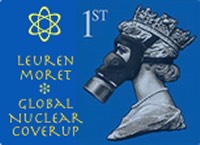


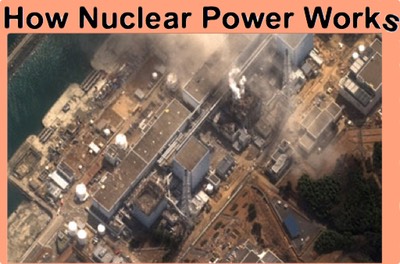

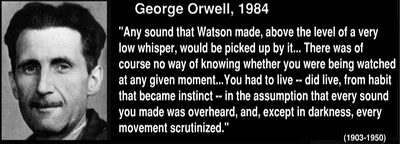
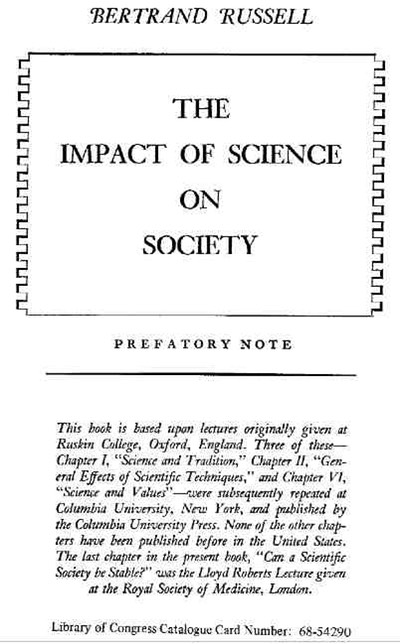

![20120724 - 7-24-2012 The More We Learn - quote from David Rockfeller -_thumb[2]](../_Media/20120724---7-24-2012-the_med_hr.jpeg)

